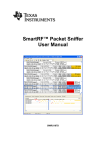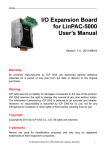Download National Instruments PCI-232/4 User's Manual
Transcript
NOTE TO USERS
USING PCI SERIAL WITH LINUX
This document contains instructions to help you install and configure the
National Instruments serial hardware for Linux. This document includes
information about the PCI-232/2, PCI-232/4, PCI-232/8, PCI-485/2,
PCI-485/4, PCI-485/8, PCI-232/2 Isolated, PCI-232/4 Isolated, PCI-485/2
Isolated, and PCI-485/4 Isolated interfaces.
This document assumes that you are already familiar with Linux.
Contents
Related Documentation........................................................................... 2
Contributions ................................................................................... 2
Gather What You Need to Get Started.................................................... 2
Quick Start .............................................................................................. 4
Setup........................................................................................................ 5
Create Devices ................................................................................. 5
MAKEDEV Example ............................................................... 5
Find Interface Information............................................................... 5
Assign Serial Driver......................................................................... 6
setserial Example ...................................................................... 7
Assign Serial Drivers Using PCI-485....................................... 7
Assign Serial Drivers Using PCI Eight-Port Interfaces............ 7
Enable PCI Interrupt ........................................................................ 7
Configuration .......................................................................................... 8
View Your Hardware Resources ..................................................... 8
Enable FIFO Buffers........................................................................ 8
FIFO Example .......................................................................... 9
Configure struct termios .................................................................. 9
Configure PCI-485 .................................................................................. 10
Select Transceiver Mode ................................................................. 10
rs485 Example .......................................................................... 10
Lower Baud Rate Selection ............................................................. 10
Test the Setup.......................................................................................... 11
natinst.com™, National Instruments™, and NI-Serial ™ are trademarks of National Instruments Corporation. Product and company names
mentioned herein are trademarks or trade names of their respective companies.
322539A-01
© Copyright 1999 National Instruments Corp. All rights reserved.
August 1999
Troubleshooting and Common Questions ...............................................12
Error Codes.......................................................................................12
Common Questions ..........................................................................13
Assign Driver...........................................................................................15
Sample /etc/rc.d/rc.serial File ..................................................................17
Related Documentation
The following documents contain information that you might find helpful
as you read this document:
•
Linux Serial-Programming-HOWTO by Peter Baumann. You can find
the latest version of this document at the following locations:
ftp://metalab.unc.edu/pub/Linux/docs/HOWTO/Serial-P
rogramming-HOWTO
http://metalab.unc.edu/LDP/HOWTO/Serial-Programming
-HOWTO.html
•
Linux Serial-HOWTO by David Lawyer. You can find the latest version
of this document at the following locations:
ftp://metalab.unc.edu/pub/Linux/docs/HOWTO/Serial-H
OWTO
http://metalab.unc.edu/LDP/HOWTO/Serial-HOWTO.html
Contributions
Thanks to Vern Howie for providing suggestions and examples from his
serial suite. Also, thanks to David Lawyer, Greg Hankins, and Peter
Baumann for providing so much information in their HOWTOs.
Gather What You Need to Get Started
Before you install your PCI serial interface for Linux, make sure you have
the following:
•
Linux kernel version 2.2.3 or later. The product has been thoroughly
tested with kernel version 2.2.3; however, the product might work with
earlier kernel versions.
If you do not have kernel version 2.2.3 or later, or if you do not have
the following options already compiled into your kernel, you need to
recompile you kernel. Include the following options when you
configure and recompile the kernel using make menuconfig.
Using PCI Serial with Linux
2
www.natinst.com
a.
b.
•
General Setup
–
PCI Support
–
PCI Quirks
–
Backward-compatible /proc/pci
Character Devices
–
Standard/generic dumb serial support
–
Extended dumb serial driver options
–
Support more than four serial ports
–
Support for sharing serial interrupts
setserial 2.14 or later. To find the version of setserial, enter the
following:
linux# setserial –V
•
PCI Utilities 1.10 or later. You can download PCI Utilities 1.10 from
ftp://metalab.unc.edu/pub/Linux/hardware
•
PCI-SERIAL.tar.gz. You can download this file from the National
Instruments FTP site at ftp://ftp.natinst.com/support/
ind_comm/serial/linux/
After you have the file, extract and unzip it by entering the following:
linux#
tar zxvf PCI-SERIAL.tar.gz
The tar command extracts and unzips PCI-SERIAL.tar.gz and
creates the sub-directory PCI-SERIAL. Enter the following to make
sure all necessary files are included:
linux#
linux PCI-SERIAL#
cd PCI-SERIAL
ls
FIFOtrigger intenable serialtest
FIFOtrigger_pci.c interrupt_enable.c serialtest.c
Clock_speed.c rs485 termios_program.c
clockspeed rs485.c
•
Configure your BIOS to include a Plug and Play aware OS.
•
You need superuser privileges to do most of the steps and program
segments in this document.
© National Instruments Corporation
3
Using PCI Serial with Linux
Quick Start
This section is for experienced Linux users who are familiar with the
lspci and setserial tools. If you are not familiar with either of these
tools or if you require a detailed explanation of the steps, skip to the next
section, Setup.
1.
If you do not have enough available serial devices ( /dev/ttyS*) for
each port on your multiport interface, create a new serial device by
entering the following:
linux# cd /dev
linux /dev# ./MAKEDEV ttyS<port number>
2.
Find the port address, IRQ, and memory assignment of your PCI serial
interface by enter the following:
linux# lspci -v -n -d 1093:*
3.
Assign the serial driver to your devices. Make sure you precede the
port addresses with 0x.
•
For a PCI-232 interface, enter the following:
linux# setserial /dev/ttyS<port number> uart
16550a port <port address> irq <irq>
^fourport
•
For a PCI-485 interface, which supports a higher baud_base of
460.8K at startup, enter the following:
linux# setserial /dev/ttyS<port number> uart
16550a port <port address> irq <irq>
baud_base 460800 ^fourport
4.
Enable the PCI interrupt on your interface. To use intenable (from
the PCI-SERIAL directory) to enable interrupts on your PCI serial
interface, enter the following:
linux PCI-SERIAL# ./intenable <pci memory address
found in lspci>
5.
If you have a PCI-485 interface, set the transceiver mode for each serial
port. Refer to the section Select Transceiver Mode for more
information about selecting a PCI-485 transceiver mode.
6.
After you connect a cable between the two ports, test the setup by
running serialtest (from the PCI-SERIAL directory).
linux#
Using PCI Serial with Linux
./serialtest <receive port number> <transmit
port number>
4
www.natinst.com
Setup
After you install the serial hardware (as shown in your PCI serial getting
started manual), follow these steps to set up the interface.
Create Devices
Create a device for each port on your multiport interface. You only need to
do this step once. Port address is the I/O address of the device, and port
number is the device/serial port number of the port. Port number is used in
the following context: ttyS<port number>. Since serial ports built into
your computer are typically named from /dev/ttyS0 to /dev/ttyS3, the
port number you choose needs to be four or greater.
Enter the /dev directory, then use the MAKEDEV script to create a device for
each serial port on the interface by entering the following.
linux# cd /dev
linux /dev# ./MAKEDEV ttyS<port number>
MAKEDEV Example
Enter the following to make the devices for a two-port interface:
linux# cd /dev
linux /dev# ./MAKEDEV ttyS4
linux /dev# ./MAKEDEV ttyS5
Find Interface Information
Follow these instructions to find the port address, IRQ, and memory
assignment of your PCI serial interface.
Note Repeat this section each time you add another interface or physical device to the
computer.
Note This step may be done in normal user mode.
1.
Use lspci (a command that displays information about the PCI bus)
with the -v option (be verbose), the -n option (show PCI vendor and
device codes as numbers), and the -d 1093:* option (display
information only on devices with a National Instruments Vendor ID
of 1093), to find the resource information of your serial interface.
linux# lspci -v -n -d 1093:*
Something similar to the following should appear. In this output, the
IRQ is 11; the memory location is 0xdff80, and the port addresses are
0xdff0 and 0xdfe0.
© National Instruments Corporation
5
Using PCI Serial with Linux
00:0a.0 Class ff00: 1093:d140 (rev 01)
Flags: medium devsel, IRQ 11
Memory at 000dff80 (low-1M, non-prefetchable)
I/O ports at dff0
I/O ports at dfe0
Write down the IRQ, memory location, and all the I/O port addresses
for your computer.
Note PCI Eight-Port Users—The PCI eight-port interfaces show only one I/O port
address listing. The addresses of the other seven I/O ports are calculated by adding eight to
the previous port address, (n × 8 + I/O port) for 0 < n < 8. The lspci call displays
something similar to the following:
00:0a.0 Class ff00: 1093:d150 (rev 01)
Flags: medium devsel, IRQ 11
Memory at 000dff80 (low-1M, non-prefetchable)
I/O ports at df00
Assign Serial Driver
Assign the serial driver to your devices.
Note You need to repeat this step each time you restart your computer or until you set up
your /etc/rc.d/rc.serial file. (Refer to the section Sample /etc/rc.d/rc.serial File for
more information on setting up the /etc/rc.d/rc.serial file.)
Enter the following to use setserial to tell the kernel each device’s
UART, port address, and IRQ. Use information returned from the lspci
output, and remember to precede the port address with 0x.
linux#
setserial /dev/ttyS<port number> uart 16550A
port <port address> irq <irq> ^fourport
Note The ^fourport flag is required regardless of how many ports you have on your
interface. The ^fourport flag tells the serial driver that you are not using an AST
four-port interface.
Caution
Using an invalid port can lock up your machine.
setserial Example
Enter the following to assign the serial driver to your devices for the values
in the above two-port lscpi output:
linux#
Using PCI Serial with Linux
setserial /dev/ttyS4 uart 16550A port 0xdff0 irq
11 ^fourport
6
www.natinst.com
linux#
setserial /dev/ttyS5 uart 16550A port 0xdfe0 irq
11 ^fourport
Assign Serial Drivers Using PCI-485
Since the PCI-485 supports a higher baud_base of 460.8K at start-up, also
enter the following at the linux prompt:
linux#
460800
setserial /dev/ttyS<port number> baud_base
For example, enter the following to assign the serial driver to /dev/ttyS4
for a PCI-485 serial port at port address 0xdfe0 and IRQ 11.
linux#
setserial /dev/ttyS4 uart 16550A port 0xdfe0 irq
11 ^fourport
linux#
setserial /dev/ttyS4 baud_base 460800
Assign Serial Drivers Using PCI Eight-Port Interfaces
Enter the following to assign the serial driver to your devices for the PCI
eight-port lspci output. Notice that the entries for port are consecutive
and are separated by exactly 8 bytes.
linux# setserial
11 ^fourport
linux# setserial
11 ^fourport
linux# setserial
11 ^fourport
linux# setserial
11 ^fourport
linux# setserial
11 ^fourport
linux# setserial
11 ^fourport
linux# setserial
11 ^fourport
linux# setserial
11 ^fourport
/dev/ttyS4 uart 16550A port 0xdf00 irq
/dev/ttyS5 uart 16550A port 0xdf08 irq
/dev/ttyS6 uart 16550A port 0xdf10 irq
/dev/ttyS7 uart 16550A port 0xdf18 irq
/dev/ttyS8 uart 16550A port 0xdf20 irq
/dev/ttyS9 uart 16550A port 0xdf28 irq
/dev/ttyS10 uart 16550A port 0xdf30 irq
/dev/ttyS11 uart 16550A port 0xdf38 irq
Enable PCI Interrupt
To enable the PCI interrupt on your serial interface, use intenable,
provided in the PCI-SERIAL directory. Run intenable each time you
restart your computer. If you have more than one PCI serial interface, rerun
intenable with another PCI memory address specified in the command
line. Enter the following to use intenable:
© National Instruments Corporation
7
Using PCI Serial with Linux
linux PCI-SERIAL# ./intenable <PCI memory address found
in lspci>
For example, enter the following to enable interrupts for a PCI serial
interface with memory at 0x000dff80:
linux PCI-SERIAL# ./intenable dff80
Configuration
View Your Hardware Resources
To see what system resources your serial interface is using, use the
setserial command, as follows:
linux# setserial -gv /dev/ttyS<port number>
For the lspci and setserial examples, something similar to the
following should appear:
/dev/ttyS0,
/dev/ttyS1,
/dev/ttyS2,
/dev/ttyS3,
/dev/ttyS4,
/dev/ttyS5,
UART:
UART:
UART:
UART:
UART:
UART:
16550A, Port: 0x03f8, IRQ: 4
unknown, Port: 0x02f8, IRQ: 3
unknown, Port: 0x03e8, IRQ: 4
unknown, Port: 0x02e8, IRQ: 3
16550A, Port: 0xdff0, IRQ: 11
16550A, Port: 0xdfe0, IRQ: 11
Enable FIFO Buffers
Use FIFOtrigger (from the PCI-SERIAL directory) to enable the receive
and transmit FIFOs and to set the trigger levels of these FIFOs.
FIFOtrigger enables the FIFO of only one serial port. To enable the FIFO
for your other serial ports, rerun FIFOtrigger with a different serial port
number specified in the command line. Enter the following to use
FIFOtrigger:
linux PCI-SERIAL#./FIFOtrigger <port number>
<rx_trigger> <tx_trigger>
Using PCI Serial with Linux
8
www.natinst.com
Table 1. tx_trigger Values
Transmit FIFO Trigger Level
tx_trigger
8
0x00
16
0x10
32
0x20
56
0x30
Table 2. rx_trigger Values
Receive FIFO Trigger Level
rx_trigger
8
0x00
16
0x40
56
0x80
60
0xC0
The hardware issues a transmit empty interrupt when the number of
characters in the transmit FIFO falls below the trigger level. Also, the
hardware issues a receive full interrupt when the number of characters in
the receive FIFO rises above the trigger level. For more information on
FIFO buffers, refer to your PCI serial getting started manual.
FIFO Example
Enter the following to set the receive FIFO trigger level to 56 and the
transmit trigger level to 32 for /dev/ttyS5:
linux PCI-SERIAL# ./FIFOtrigger 5 0x80 0x20
Configure struct termios
Every serial port has an associated struct termios. By using this
struct termios in a program, you can set the baud rate, character size
(number of data bits), parity, control characters, flow control, and input and
output mode. For more information about the termios structure, refer to the
termios man page. To view the termios man page, enter the
following:
linux# man termios
To configure your serial port, use a program segment similar to the
termios_program.c in your PCI-SERIAL directory.
© National Instruments Corporation
9
Using PCI Serial with Linux
Configure PCI-485
If you are using a PCI-485 interface, you can select the transceiver
mode for each device and select the lower baud rates listed in
termios_program.c provided in your PCI-SERIAL directory.
Select Transceiver Mode
Use the rs485 program (from the PCI-SERIAL directory) to select the
transceiver mode. rs485 sets the transceiver mode for only one serial port.
To set the transceiver mode for other serial ports, rerun rs485 with a
different serial port number specified in the command line. For more
information on the transceiver control modes, refer to your serial getting
started manual. If you do not know which transceiver mode to use, choose
Four-Wire Mode.
Table 3. Transceiver Mode Values
Transceiver Mode
Mode
Four-Wire Mode
0
Two-Wire Mode: DTR with echo
1
Two-Wire Mode: DTR controlled
2
Two-Wire Mode: TXRDY auto
control
3
Enter the following to use rs485:
linux PCI-SERIAL# ./rs485 <port number> <mode>
rs485 Example
Enter the following to select Four-Wire Mode for /dev/ttyS5:
linux PCI-SERIAL# ./rs485 5 0
Lower Baud Rate Selection
To use a baud rate lower than 200, use setserial and the clockspeed
program (from the PCI-SERIAL directory) to lower the baud base of a
single serial port from 460800 to 115200. After changing the baud base
to 115200, the max baud rate you can achieve is 115200 baud (until you
change the baud base back to 460800).
After you change the baud_base of the serial port using setserial and
run the clockspeed program, you can use the lower baud rate flags in
your programs. The clockspeed program changes the baud base of only
Using PCI Serial with Linux
10
www.natinst.com
one serial port. To change the baud base of your other serial ports, rerun
clockspeed with a different serial port number specified in the command
line. Enter the following to set the baud base. (In this example, high equals
a baud base of 460800 and low equals a baud base of 115200):
linux# setserial /dev/ttyS<port number> baud_base 115200
linux PCI-SERIAL#./clockspeed <port number> <"high" or
"low">
For example, enter the following to select a baud base of 115200 for
/dev/ttyS4 and for /dev/ttyS5:
linux# setserial /dev/ttyS4 baud_base 115200
linux# setserial /dev/ttyS5 baud_base 115200
linux PCI-SERIAL# ./clockspeed 4 low
linux PCI-SERIAL# ./clockspeed 5 low
Enter the following to change the baud base back to 460800 for
/dev/ttyS4 and for /dev/ttyS5:
linux# setserial /dev/ttyS4 baud_base 460800
linux# setserial /dev/ttyS5 baud_base 460800
linux PCI-SERIAL# ./clockspeed 4 high
linux PCI-SERIAL# ./clockspeed 5 high
Test the Setup
After you connect the cables to the port (as shown in your PCI serial getting
started manual), run the serialtest program (from the PCI-SERIAL
directory) to verify your setup. Make sure you specify two different ports
for the serialtest program, as shown in the following:
linux PCI-SERIAL# ./serialtest <receive port number>
<transmit port number>
If the test is successful, it displays a SUCCESS message. If the test hangs,
press <ctrl-c> to exit the program, and continue to the next section,
Troubleshooting and Common Questions.
To test /dev/ttyS4 and /dev/ttyS5, connect a cable between the
two ports and enter the following:
linux PCI-SERIAL# ./serialtest 4 5
© National Instruments Corporation
11
Using PCI Serial with Linux
Troubleshooting and Common Questions
Error Codes
This section lists possible error codes and solutions.
Error Code
/dev/ttyS<port number>: no such file or directory
Solution
The /dev/ttyS<port number> does not exist in the /dev directory. Enter the
following to create the device:
linux# cd /dev
linux /dev# ./MAKEDEV ttyS<port number>
Error Code
Couldn't change i/o privilege level: Operation not permitted
Solution
The program requires superuser privileges. Either exit and log in as root, or enter
the following:
linux$ su
Password: <enter the root password>
linux# <run the program>
Error Code
setserial: Cannot set serial info: Address already in use
Solution
Make sure you are entering the correct port address into setserial. Also, make
sure you are entering 0x if you are specifying a hex number.
linux# setserial /dev/ttyS<port number> uart 16550a port
0x<port address> irq <irq> ^fourport
Error Code
intenable: Can't open /dev/mem: Permission denied
Solution
The program requires superuser privileges. Either exit and log in as root, or enter
the following:
linux$ su
Password: <enter the root password>
linux# ./intenable <PCI memory>
Using PCI Serial with Linux
12
www.natinst.com
Error Code
intenable: ERROR: Initial value of interrupt enable register
not equal to 0xC0C
Solution
Make sure that you are providing the program with the correct memory address.
Enter the following to check for the memory address:
linux# lspci -v -n -d 1093:*
00:0a.0 Class ff00: 1093:d150 (rev 01)
Flags: medium devsel, IRQ 11
Enter this address! -->Memory at 000dff80 (low-1M,
non-prefetchable)
I/O
I/O
I/O
I/O
ports
ports
ports
ports
at
at
at
at
dff0
dfe0
dfa8
dfa0
linux# ./intenable dff80
Error Code
rs485: ERROR: Couldn't write to /dev/ttyS<port number>'s
scratch register
Solution
Make sure the device was configured correctly in setserial. Enter the
following:
linux# setserial -gv /dev/ttyS<port number>
/dev/ttyS4, UART: 16550A, Port: 0xdff0, IRQ: 11
If the port listing does not match the one found by lspci, reconfigure the device
by entering the following:
linux# setserial /dev/ttyS<port number> uart 16550a port
<port> irq <irq> ^fourport
Common Questions
What do I do if intenable does not work immediately or causes a
segmentation fault?
Enter the following to recompile interrupt_enable.c and rerun
intenable. Also, the source code for intenable is available for editing
and viewing at interrupt_enable.c provided in the PCI-SERIAL
directory.
linux PCI-SERIAL# gcc interrupt_enable.c -o intenable
linux PCI-SERIAL# ./intenable <PCI memory address found
in lspci>
© National Instruments Corporation
13
Using PCI Serial with Linux
What do I do if FIFOtrigger does not work immediately or causes a
segmentation fault?
Enter the following to recompile FIFOtrigger_pci.c and rerun
FIFOtrigger. Also, the source code for FIFOtrigger is available for
editing and viewing at FIFOtrigger_pci.c provided in the
PCI-SERIAL directory.
linux PCI-SERIAL# gcc -O FIFOtrigger_pci.c -o
FIFOtrigger
linux PCI-SERIAL# ./FIFOtrigger <port number>
<rx_trigger> <tx_trigger>
What do I do if rs485 does not work immediately?
Enter the following to recompile rs485.c. Also, the source code for
rs485 is available for editing and viewing at rs385.c, provided in the
PCI-SERIAL directory.
linux PCI-SERIAL# gcc -O rs485.c -o rs485
What do I do if clockspeed does not work immediately or if it causes
a segmentation fault?
Enter the following to recompile clock_speed.c and rerun
clockspeed. Also, the source code for clockspeed is available for
editing and viewing at clock_speed.c, provided in the PCI-SERIAL
directory.
linux PCI-SERIAL# gcc -O clock_speed.c -o clockspeed
linux PCI-SERIAL# ./clockspeed <port number> <high/low>
What do I do if serialtest does not work immediately or if it causes
a segmentation fault?
Enter the following to recompile serialtest.c and rerun serialtest.
Also, the source code for serialtest is available for editing and viewing
at serialtest.c, provided in the PCI-SERIAL directory.
linux PCI-SERIAL# gcc serialtest.c -o serialtest
linux PCI-SERIAL# ./serialtest <receive port number>
<transmit port number>
What do I do if serialtest hangs?
Make sure the interface is seated correctly and tighten the screw that holds
the interface in place. Also, make sure the cables are attached to the correct
ports. In some cases, serialtest hangs if the transceiver modes
(PCI-485) are not set. Try setting both transmit and receive ports to
transceiver mode 0 (Four-Wire Mode).
Using PCI Serial with Linux
14
www.natinst.com
linux# ./rs485 <transmit port number> 0
linux# ./rs485 <receive port number> 0
linux# ./serialtest <receive port number> <transmit port
number>
What do I do if my ports are not communicating correctly and print
strange characters?
Make sure the baud rate, character size, clock speed (if PCI-485) and parity
are the same for both the receiver and transmitter. Also make sure the
transceiver modes (PCI-485) have been selected for both transceivers.
How can I use /dev/ttyS0, /dev/ttyS1, /dev/ttyS2, or
/dev/ttyS3 as National Instruments serial ports?
Check for available serial devices by entering the following:
linux#
setserial -gv /dev/ttyS*
/dev/ttyS0,
/dev/ttyS1,
/dev/ttyS2,
/dev/ttyS3,
UART:
UART:
UART:
UART:
16550A, Port: 0x03f8, IRQ: 4
unknown, Port: 0x02f8, IRQ: 3
unknown, Port: 0x03e8, IRQ: 4
unknown, Port: 0x02e8, IRQ: 3
Devices labeled with UART: unknown are available for use. To designate
the available device when using setserial, enter the following:
linux#
setserial /dev/ttyS<port number> uart 16550a
port 0x<port address> irq <irq> ^fourport
Assign Driver
Use these instructions to automatically assign the driver at startup using
/etc/rc.d/rc.serial.
You should not change the /etc/rc.d/rc.serial file until you have
your serial interfaces installed and configured. If you add another device or
interface to your computer, and your lspci output changes, make sure you
also change /etc/rc.d/rc.serial.
Depending on your Linux distribution, you might not have an /etc/rc.d/
directory. In this case, your rc.serial would be located under
/etc/rc.serial. If you do not have /etc/rc.d/, replace the references
to /etc/rc.d/ with /etc/. If you are using a Debian distribution, replace
the references to /etc/rc.d/rc.serial with
/etc/rc.boot/0setserial.
© National Instruments Corporation
15
Using PCI Serial with Linux
For more information about using setserial, refer to linux # more
/usr/doc/setserial*/README.
1.
Enter the following:
linux#
linux#
a.
cp /usr/doc/setserial*/rc.serial /etc/rc.d/
pico /etc/rc.d/rc.serial
Make sure that SETSERIAL= points to the correct location. Check
your /bin and /sbin directories, and change the SETSERIAL=
line to say either SETSERIAL=/bin/setserial or
SETSERIAL=/sbin/setserial
b.
Under AUTOMATIC CONFIGURATION, leave the following lines
uncommented and delete or comment out (by adding a # to the
beginning of the line) all the other lines in the section. (Depending
on your version of setserial, ttyS might replace cua):
AUTO_IRQ=auto_irq
${SETSERIAL} /dev/cua0 ${AUTO_IRQ} skip_test
autoconfig ${STD_FLAGS}
${SETSERIAL} /dev/cua1 ${AUTO_IRQ} skip_test
autoconfig ${STD_FLAGS}
${SETSERIAL} /dev/cua2 ${AUTO_IRQ} skip_test
autoconfig ${STD_FLAGS}
${SETSERIAL} /dev/cua3 ${AUTO_IRQ} autoconfig
${STD_FLAGS}
c.
Under MANUAL CONFIGURATION, comment out or delete
everything but the following lines. Change the lines concerning
/dev/cua4-/dev/cua(4+n) (where n is the number of ports on
the PCI serial interface) to the following:
# These are the first set of
#
${SETSERIAL} /dev/ttyS4 uart
address> irq <irq> ^fourport
${SETSERIAL} /dev/ttyS5 uart
address> irq <irq> ^fourport
${SETSERIAL} /dev/ttyS6 uart
address> irq <irq> ^fourport
${SETSERIAL} /dev/ttyS7 uart
address> irq <irq> ^fourport
AST Fourport ports
16550A port <port
16550A port <port
16550A port <port
16550A port <port
Refer to the section Sample /etc/rc.d/rc.serial File for an example
(configured according to the lspci example above).
2.
Enter the following:
linux#
Using PCI Serial with Linux
pico /etc/rc.d/rc
16
www.natinst.com
3.
Add the following segment to the end of the file (not necessary for
Debian distribution):
if [ -f /etc/rc.d/rc.serial ]; then
sh /etc/rc.d/rc.serial
fi
Sample /etc/rc.d/rc.serial File
#
# /etc/rc.d/rc.serial
#
Initializes the serial ports on your system
#
# Distributed with setserial version 2.14
#
# Standard flags you want your serial devices to have
# Examples: SAK, pgrp_lockout, session_lockout
#
STD_FLAGS="session_lockout"
SETSERIAL=/bin/setserial
echo -n "Configuring serial ports...."
# Do wild interrupt detection
#
${SETSERIAL} -W /dev/cua0
###############################################################
#
# AUTOMATIC CONFIGURATION
#
###############################################################
# Do AUTOMATIC_IRQ probing
#
AUTO_IRQ=auto_irq
# These are the standard COM1 through COM4 devices
#
#
${SETSERIAL} /dev/cua0 ${AUTO_IRQ} skip_test autoconfig ${STD_FLAGS}
${SETSERIAL} /dev/cua1 ${AUTO_IRQ} skip_test autoconfig ${STD_FLAGS}
${SETSERIAL} /dev/cua2 ${AUTO_IRQ} skip_test autoconfig ${STD_FLAGS}
${SETSERIAL} /dev/cua3 ${AUTO_IRQ} autoconfig ${STD_FLAGS}
###############################################################
#
# MANUAL CONFIGURATION
#
###############################################################
© National Instruments Corporation
17
Using PCI Serial with Linux
# Changed for the two-port PCI-SERIAL interface.
#
${SETSERIAL} /dev/ttyS4 uart 16550A port 0xdff0 irq 11 ^fourport
${SETSERIAL} /dev/ttyS5 uart 16550A port 0xdfe0 irq 11 ^fourport
###########################################################
#
# Print the results of the serial configuration process
#
###########################################################
echo "done."
${SETSERIAL} -bg /dev/cua? /dev/cua??
Using PCI Serial with Linux
18
www.natinst.com




























